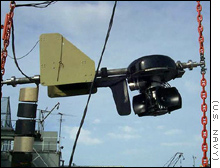|
At this point, it might be argued that cetaceans are in fact reverse engineered fish in that they require direct access to oxygen for their lungs indicative of their terrestrial ancestry, rather than the ability to extract it from the water with the aid of gills, which they would still have, if, as a species, they had failed to make the evolutionary journey to the land.
Marine species through the process of natural selection have gradually evolved via the process of genetic selection of mutations that were better adapted to make use of specific abilities. The better an organism is at finding or catching food the more likely it is to grow to maturity, the better it is at avoiding becoming food for another species, the more likely it is that the organism will survive long enough to reproduce. So the more “adapted” a species becomes to its environment, the more likely it is to develop further evolutionary characteristics ensuring species survival. If it has the ability to moderate its own environment, it has the ability to control the adaptation of other species directly and so adapt them for its purposeful use. (So called domesticated animals – the development of systems of farming in place of a nomadic, environment driven existence, rather than a purely mutual beneficial symbiotic relationship or dependency.)
Marine species have developed, in the main, to make the best use of relatively low levels of sound energy transmission, and, as such, are highly sensitive to sound energy, and small changes in that emission by other organisms either created intentionally - the whistles and clicks of dolphins, the clicks of porpoises, the booming of whales, the barks of sea lions, or the unintentional sounds created by the sick or injured organisms attracting the attention of those species that prey upon them – we know that many species are attracted by vibrations that indicate the presence of more easily caught food. The detecting mechanism varies according to the species; in fish it may be a row of vibration sensitive scales, in marine mammals an ear not too dissimilar from a terrestrial mammal, or an environmental adaptation/variation enabling vibration detection, albeit naturally selected by the need to be at its most sensitive in the range of frequencies that are synonymous with an existence driven by the needs of survival in a marine environment.
To introduce a series of repeated high-energy audio emissions into such an environment would seem to show little recognition of the potential impact upon an already struggling ecosystem. The sound emission from sonar arrays is known to alter the behaviour of some fish species. Cetaceans have been observed to detour from migratory routes in order to avoid the source of high-energy sound emissions.
In March 2000, the US Navy deployed a powerful mid-range
sonar during a submarine detection exercise in the
deep-water canyons of the Bahamas.
This resulted in at least 16 whales and 2 dolphins beaching
themselves on the islands of Abaco, Grand Bahama and
North Eleuthera within hours.
8 of the whales died.
Post-mortems revealed haemorrhaging around the brain and ear bones, injuries consistent with exposure to loud sounds.
In 1996, twelve Cuvier’s beaked whales beached themselves in Greece, during NATO exercises when low-frequency sonar was used, but the whales decomposed before scientists could investigate.
It would seem that having exposed marine life to a continued barrage of harmful chemicals, seismological surveys, cyclic engine thump and turbine whine, the sporadic explosion of depth charges, torpedoes, anti-ship mines, explosives fishing techniques, we, a supposedly sensitive species, are about to subject a diverse group of species to an outdated mid-twentieth century “sonar” tracking technique which has the capability to reveal the location of “friendly” submarines as well as “hostiles”.
To object to the use of this technique is to be branded a “subversive” or “un-patriotic.”
These labels are neither correct, nor justified.
Further information about the Surveillance Towed Array Sensor System (SURTASS) Low Frequency Active (LFA) the “new” sonar, can be found on the U.S. Navy web site
online at: http://www.surtass-lfa-eis.com
Anti-Submarine warfare (ASW) is an essential part of any Navy’s defence strategy. Submarines are the ultimate stealth weapons, and a Navy must be able to detect them at long distances before they pose a danger to surface ships. Methods are available that have neither catastrophic effects upon cetaceans nor pose a threat to other marine flora and fauna.
Equally they do not expose allied surface shipping or submarines to identification by hostile submarines and subsequent attack
All governments currently developing or considering the development of such means of detection are strongly urged to consider the long term effect this type of defensive measure and to make use of techniques that do not have the potential to cause irreversible environmental damage.
Alan Stuart
|
